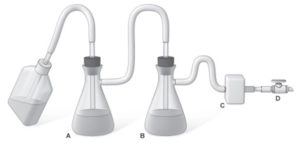These are devices that sterilize cultures, media, surgical instruments, and medical waste. Autoclaves sterilize on the basis of:
- length of time in the cycle
- temperature
- contact
- pressure
- steam
An autoclave is suitable for treating certain (but not all) types of medical waste. The following cannot be autoclaved:
- Medical waste, mixed with volatile chemical solvents or radioactive materials, which should be handled as either chemical or radioactive waste
- Pathological waste.
Unless otherwise stated, it is not necessary to autoclave materials prior to medical waste disposal. Exceptions to this are users of BSL-3 biohazardous agents.
If sterilizing non-disposable items used during work with prions or prion-like proteins, follow guidelines from the Centers for Disease Control and Prevention (CDC) and the World Health Organization (WHO).
Each department is responsible for training personnel on autoclave use. Please use the Autoclave Safety Safety Fact Sheet: (English) and (Spanish) as guides for training.
For general information, see the Stanford University Biosafety Manual, Chapter 9.
Biological safety cabinets (BSC), also known as tissue culture hoods, are designed to provide three types of protection:
- Personal protection for the staff from material inside the cabinet
- Protection for the material inside of the cabinet from outside contamination
- Protection for the environment from the material inside of the cabinet
There are three types of BSCs: Class I, II, and III. The use of Class I BSCs is not advised at Stanford. Contact Biosafety if you feel you need to purchase one. Please refer to the table and Chapter 7.3 in the Biosafety Manual to select a cabinet that is appropriate for your needs.
Selection of a Cabinet Through Risk Assessment
Biological Risk Assessed Protection Provided BCS Class Personnel Product Environmental BSL 1-3 YES NO YES I BSL 1-3 YES YES YES II (A, B1, B2, B3) BSL 4 YES YES YES III (B1, B2) Biosafety cabinets must be installed by certified professionals. Stanford University uses Technical Safety Services, Inc. for installations, cabinet certifications (required annually), decontamination, and other, similar needs. The PI or the Department is responsible for scheduling any of the above work. TSS, Inc. can be reached at (510) 845-5591. You can find more information on the Biosafety Cabinet Use and Certification service page.
Use the Biosafety Cabinet Use and Safety (available in Chinese), Biosafety Cabinet General Use Procedures and Use of Open Flames in Biosafety Cabinets SOP, along with the videos, for BSC training listed below:
- Effective Use of Class II Biosafety Cabinets
- Biosafety Cabinet Use with Particle Demo
- The Bad Laboratorian
Vacuum Flask Aspirator Options:
- Dual flask system with HEPA filter (C)

- Bel-Art Scienceware Vacuum Aspirator Bottle (use with HEPA filter): 0.5 gal. and 1 gal. options

Links to purchase:
- https://www.belart.com/vacuum-aspirator-bottles.html
- https://www.fishersci.com/shop/products/bel-art-scienceware-vacuum-aspirator-bottles-2/p-3623196#?keyword=vacuum+aspirator
- http://www.sigmaaldrich.com/catalog/product/aldrich/z675490?lang=en®ion=US
- https://www.sigmaaldrich.com/catalog/product/aldrich/baf199170002?lang=en®ion=US
Use of this type of machine for unfixed cells and/or infectious agents can create a droplet hazard for users. Please see Sorting Unfixed (Live) Cells Guidance (available in Chinese) for information on this procedure.
You have two Vacuum Flask Aspirator Options:
1. Dual flask system w/ HEPA filter (C)
2. Bel-Art Scienceware Vacuum Aspirator Bottle (use with HEPA filter): 0.5 gal. and 1 gal. options
Links to purchase:
- https://www.belart.com/vacuum-aspirator-bottles.html
- https://www.fishersci.com/shop/products/bel-art-scienceware-vacuum-aspirator-bottles-2/p-3623196#?keyword=vacuum+aspirator
- http://www.sigmaaldrich.com/catalog/product/aldrich/z675490?lang=en®ion=US
- https://www.sigmaaldrich.com/catalog/product/aldrich/baf199170002?lang=en®ion=US
